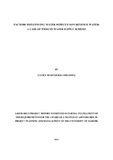Spatio-temporal patterns of domestic water distribution, consumption and sufficiency: Neighbourhood inequalities in Nairobi, Kenya

View/
Date
2022-01Author
Mutono, N.
Wright, J
Mutembei, H.
Thumbi, S. M.
Type
ArticleLanguage
en_USMetadata
Show full item recordAbstract
Whilst there are longstanding and well-established inequalities in safe-drinking water-access between urban and rural areas, there remain few studies of changing intra-urban inequalities over time. In this study, we determined the spatio-temporal patterns of domestic piped water distribution in Nairobi, Kenya between 1985 and 2018, and the implications of socio-economic and neighbourhood inequalities in water sufficiency. Using data from the Nairobi water and sewerage utility company for the period 2008–2018, we examined the sufficiency of monthly domestic water consumption per capita for 2380 itineraries (areas with an average population of 700) in relation to a residential neighbourhood classification, population and neighbourhood age and also examined water rationing patterns by neighbourhood type. Water sufficiency differed by residential areas, age of neighbourhood and population per itinerary. Compared to residents of low-income areas, those in high- and middle-income areas were six and four times more likely to receive the recommended 1500 L per capita per month respectively. Newer neighbourhoods and less densely populated areas were more likely to receive higher volumes of water. Non-revenue water loss accounted for 29% (average 3.5 billion litres per month) of water distributed across Nairobi, and was more than two times the amount of water needed for all residents to access the recommended monthly per capita water consumption. The observed spatial inequality in distribution, and access to piped water associated with socio-economic status and neighbourhood age highlights the need for deliberate planning and governance to improve water distribution to match the speed of growth of low/middle- and low-income residential areas and enhance equity.
URI
https://www.sciencedirect.com/science/article/pii/S019739752100165Xhttp://erepository.uonbi.ac.ke/handle/11295/161234
Citation
Mutono, N., Wright, J., Mutembei, H., & Thumbi, S. M. (2022). Spatio-temporal patterns of domestic water distribution, consumption and sufficiency: Neighbourhood inequalities in Nairobi, Kenya. Habitat International, 119, 102476.Publisher
Elsevier
Subject
Water distributionWater sufficiencyWater inequalityUrban water consumptionSustainable developmentCollections
Related items
Showing items related by title, author, creator and subject.
-
Factors Influencing Water Supply’s Non Revenue Water: A Case Of Webuye Water Supply Scheme
Shilehwa, Celsus M (University of Nairobi,Department of Education Administration & Planning, 2013)This study was carried out to examine the factors influencing water supply’s non revenue water (NRW): a case of Webuye water supply scheme of Nzoia Water Services Company Limited (NZOWASCO). The study was conducted under ... -
Effects of Water Sources and Watering Frequency for Dairy Cattle on Water offered and Milk Production in Kiambu District
Muli, A N; Gachuiri, C K; Wahome, R G; Tanner, J; Kaitho, R (Departmeni of Animal Production, 2002)Data on water sources, mode of offer, watering frequency, amount of water offered, body weights and milk yield were collected from 21 randomly selected smallholder farms by means of farm visits and questionnaires ... -
Application of GIS estimation water runoff volume in water collection sites: case study of northern collector water tunnel
Kimeli, Noah (University of Nairobi, 2017-08)Surface runoff isasinglemost significanthydrological variablethat isutilizedin many civil works, planning for optimal usageof reservoirs, shapingrivers and floodcontrol.Predictionand quantification of catchment runoffis ...


